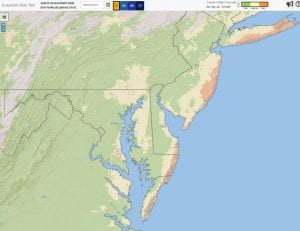Alyssa Koehler, Extension Field Crops Pathologist; akoehler@udel.edu
Across much of the region, barley is approaching or at heading and wheat is ranging from Feekes 7-9. There have been a few reports of scattered powdery mildew, but nothing at levels warranting a fungicide application. In barley, flowering begins just before the spike emerges from the boot. While florets are not as susceptible, Fusarium can infect the glumes and produce DON. DON accumulation is the primary concern, especially for malting barley acreage. The Fusarium Risk Tool http://www.wheatscab.psu.edu/ has the west part of the state at low risk, while coastal areas are at medium to high (Figure 1). If making a fungicide application to manage FHB in barley, the optimum stage to protect barley glumes is when the spike is fully emerged from the boot and florets are exposed (Figure 2). In 2020, a trial was conducted in Violetta malting barley looking at three timings of Miravis Ace application in comparison to Prosaro and Caramba. FHB incidence and severity were reduced by all fungicide treatments (Figure 2). Due to the timing of flowering, spraying barley a little early is usually better than spraying late. In wheat, ideal application is Feekes 10.5.1 (anthesis), when yellow anthers are visible in the center of the spike. While application of Miravis Ace at 10.3 in wheat can reduce disease, lowest DON has been observed with application at 10.5.1 or up to 4-6 days after 10.5.1.

Figure 1. Fusarium Risk Tool Prediction for April 22, 2021

Figure 2. Stages of barley at or near spike emergence, with the furthest right spike at optimum stage for fungicide application.

Summary of 2020 Malting Barley Fungicide Efficacy Trial
